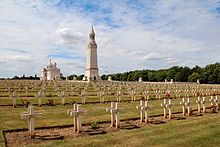Notre-Dame-de-Lorette French National Cemetery
The French National Cemetery Notre-Dame-de-Lorette ( French Nécropole nationale de Notre-Dame-de-Lorette ) in the municipality of Ablain-Saint-Nazaire in the Pas-de-Calais department is a French military cemetery and one of nine in 2014 by the French Ministry of Defense memorials declared as “high national places of remembrance” (French: hauts lieux de la mémoire nationale ). Over 43,000 French casualties from the First World War are buried here on an area of 27 hectares , around 20,000 of them in individual graves and 23,000 in eight ossuaries .
history
From 1914 to 1918, a part of the Western Front ran between Arras and Lens , in which several major battles with French participation took place. The first fighting took place in autumn 1914, during the " Race to the Sea ". Two large-scale French offensives followed in 1915, known in German as the Loretto Battle or the Spring Battle at La Bassée and Arras and the Autumn Battle at La Bassée and Arras . The "Lorettoschlacht" was named after the "Lorettohöhen" (also height 165 ), after the chapel "Notre Dame de Lorette", which was originally built here by a local in the 18th century in memory of a pilgrimage to Loreto (Italy) . It is estimated that 100,000 French soldiers were killed in the fighting in this area from October 1914 to October 1915 alone. The hill with the chapel was completely devastated during the fighting.
After the war, the French government decided to create a nécropole nationale on the Lorettohöhe , which was named Notre-Dame de Lorette . The military cemetery, originally laid out in 1915, was expanded and the remains of soldiers from more than 150 cemeteries from the entire northern combat area from Artois and Flanders to the Belgian coast were reburied here.
The architect Louis Marie Cordonnier was commissioned by a committee founded in 1920, which included the Bishop of Arras Eugène Julien , the politician Charles Jonnart , the engineer Paul Louis Weiss and the General Paul Maistre , to design a basilica and a lantern tower for the memorial design. Marshal Philippe Pétain laid the symbolic foundation stone for the lantern tower on June 19, 1921, construction of the basilica in neo-Byzantine style began in 1923, and the shell was completed four years later. The inauguration of the facility by Prime Minister Paul Painlevé took place in August 1925.
layout

The rectangular complex, surrounded by a circular path, extends in an east-west direction on the hill a few hundred meters north of Ablain-Saint-Nazaire. The burial ground measures 645 by 200 meters, the central square is occupied by the lantern tower and the basilica. At the west end of the cemetery are the ossuaries 1–5, to the east of the lantern tower the ossuaries 3 bis and 4 bis. The eighth ossuary is the crypt under the lantern tower.
The original wooden crosses of the individual graves were replaced by cement crosses in the 1930s. A Muslim area comprises over 550 individual graves. There are around 60 individual graves for Russian soldiers as well as individual graves for those who died in other allied nations in the First World War.
The death lamp at the top of the 52 meter high lantern tower rotates at five revolutions per minute and is visible from afar in the dark. In the crypt there are graves for the unknown soldier of the Second World War (since 1950), urns with the ashes of the French deported during the Second World War (since 1955) and graves of the unknown soldiers of the Algerian War (since 1977) and the Indochina War (since 1980) .
In the southern entrance area of the facility is the International Memorial to the Fallen (“Ring of Remembrance” ), inaugurated on November 11, 2014 (Armistice Day) with the engraved names of almost 580,000 soldiers from all participating nations who died in the Nord-Pas-de-Calais region . To the northwest of the cemetery is a museum that is open every day and an approximately 3 hectare piece of the preserved battlefield. Another museum is located in nearby Souchez .
See also
Web links
- Website of the Association du monument de Notre-Dame de Lorette (French)
- Notre-Dame-de-Lorette on cheminsdememoire.gouv.fr
- Notre-Dame-de-Lorette National Cemetery on the Lens 14-18 pages
- Private homepage with old pictures (French)
Footnotes
- ↑ Notre-Dame-de-Lorette at cheminsdememoire
- ↑ Notre-Dame de Lorette on the pages of the municipality of Ablain-Saint-Nazaire.
Coordinates: 50 ° 24 '3.6 " N , 2 ° 43' 8.4" E




